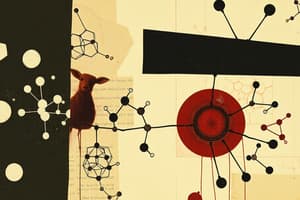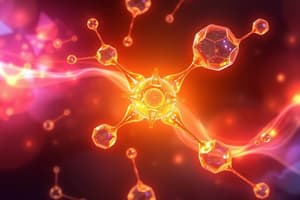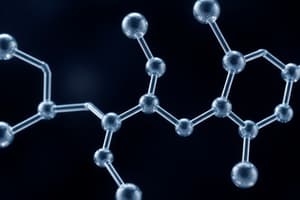Podcast
Questions and Answers
What is the primary focus of Organic Synthesis?
What is the primary focus of Organic Synthesis?
- Exploring the chemical processes within living organisms
- Investigating the step-by-step processes of organic reactions
- Constructing organic compounds from simpler starting materials (correct)
- Studying the physical properties of organic compounds
What is the term for a specific group of atoms within a molecule that determines its chemical properties?
What is the term for a specific group of atoms within a molecule that determines its chemical properties?
- Functional group (correct)
- Molecular formula
- Reaction mechanism
- Structural isomer
What type of isomerism occurs when two molecules have the same molecular formula but differ in their bond connectivity?
What type of isomerism occurs when two molecules have the same molecular formula but differ in their bond connectivity?
- Diastereomerism
- Structural isomerism (correct)
- Stereoisomerism
- Enantiomerism
What is the term for a non-superimposable stereoisomer that is a mirror image of another?
What is the term for a non-superimposable stereoisomer that is a mirror image of another?
What type of reaction involves the replacement of a leaving group by a nucleophile?
What type of reaction involves the replacement of a leaving group by a nucleophile?
What is the measure of the acidity of a molecule?
What is the measure of the acidity of a molecule?
What is the term for the reaction involving the transfer of a proton from an acid to a base?
What is the term for the reaction involving the transfer of a proton from an acid to a base?
What branch of organic chemistry focuses on the chemical processes that occur within living organisms?
What branch of organic chemistry focuses on the chemical processes that occur within living organisms?
Flashcards are hidden until you start studying
Study Notes
Branches of Organic Chemistry
- Physical Organic Chemistry: studies the physical properties and reactions of organic compounds
- Organic Synthesis: focuses on the construction of organic compounds from simpler starting materials
- Organic Reaction Mechanisms: investigates the step-by-step processes by which organic reactions occur
- Bioorganic Chemistry: explores the chemical processes that occur within living organisms
Functional Groups
- A functional group is a specific group of atoms within a molecule that determines its chemical properties
- Common functional groups include:
- Alkyl (R-)
- Alkenyl (R-CH=CH-)
- Alkynyl (R-C≡C-)
- Hydroxyl (R-OH)
- Carboxyl (R-COOH)
- Amino (R-NH2)
Isomerism
- Structural Isomerism: occurs when two molecules have the same molecular formula but differ in their bond connectivity
- Stereoisomerism: occurs when two molecules have the same molecular formula and bond connectivity but differ in their three-dimensional arrangement
- Enantiomers: non-superimposable stereoisomers that are mirror images of each other
- Diastereomers: non-superimposable stereoisomers that are not mirror images of each other
Reaction Mechanisms
- Nucleophilic Substitution: a reaction in which a nucleophile (an electron-rich species) replaces a leaving group in a molecule
- Electrophilic Addition: a reaction in which an electrophile (an electron-poor species) adds to a molecule, often forming a new bond
- Elimination: a reaction in which a leaving group is removed from a molecule, often resulting in the formation of a new bond
Acidity and Basicity
- pKa: a measure of the acidity of a molecule, with lower pKa values indicating greater acidity
- pKb: a measure of the basicity of a molecule, with lower pKb values indicating greater basicity
- Acid-Base Reactions: reactions involving the transfer of a proton (H+ ion) from an acid to a base
Branches of Organic Chemistry
- Physical Organic Chemistry explores the physical properties and reactions of organic compounds
- Organic Synthesis focuses on constructing organic compounds from simpler starting materials
- Organic Reaction Mechanisms investigates the step-by-step processes of organic reactions
- Bioorganic Chemistry examines the chemical processes occurring within living organisms
Functional Groups
- A functional group determines the chemical properties of a molecule
- Functional groups include:
- Alkyl (R-)
- Alkenyl (R-CH=CH-)
- Alkynyl (R-C≡C-)
- Hydroxyl (R-OH)
- Carboxyl (R-COOH)
- Amino (R-NH2)
Isomerism
- Structural Isomerism occurs when molecules have the same molecular formula but differ in bond connectivity
- Stereoisomerism occurs when molecules have the same molecular formula and bond connectivity but differ in 3D arrangement
- Enantiomers are non-superimposable stereoisomers that are mirror images of each other
- Diastereomers are non-superimposable stereoisomers that are not mirror images of each other
Reaction Mechanisms
- Nucleophilic Substitution is a reaction where a nucleophile replaces a leaving group in a molecule
- Electrophilic Addition is a reaction where an electrophile adds to a molecule, often forming a new bond
- Elimination is a reaction where a leaving group is removed from a molecule, often forming a new bond
Acidity and Basicity
- pKa measures the acidity of a molecule, with lower values indicating greater acidity
- pKb measures the basicity of a molecule, with lower values indicating greater basicity
- Acid-Base Reactions involve the transfer of a proton (H+ ion) from an acid to a base
Studying That Suits You
Use AI to generate personalized quizzes and flashcards to suit your learning preferences.




